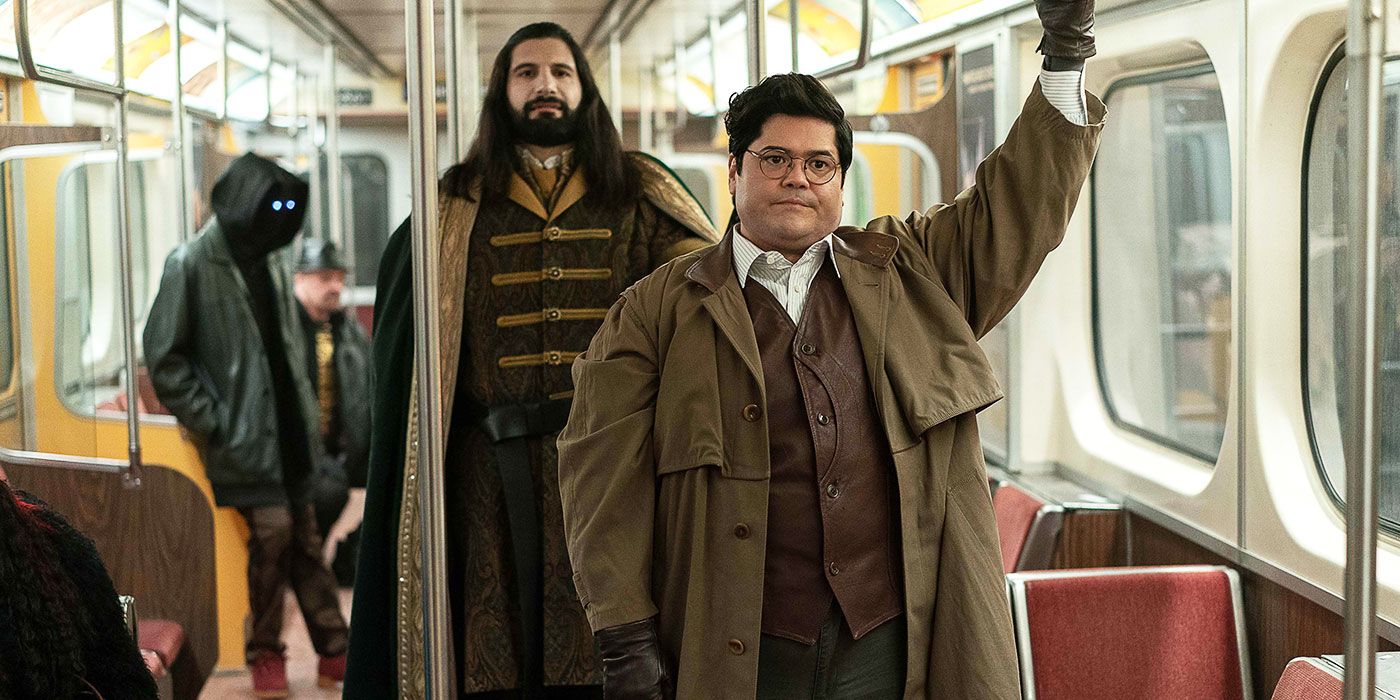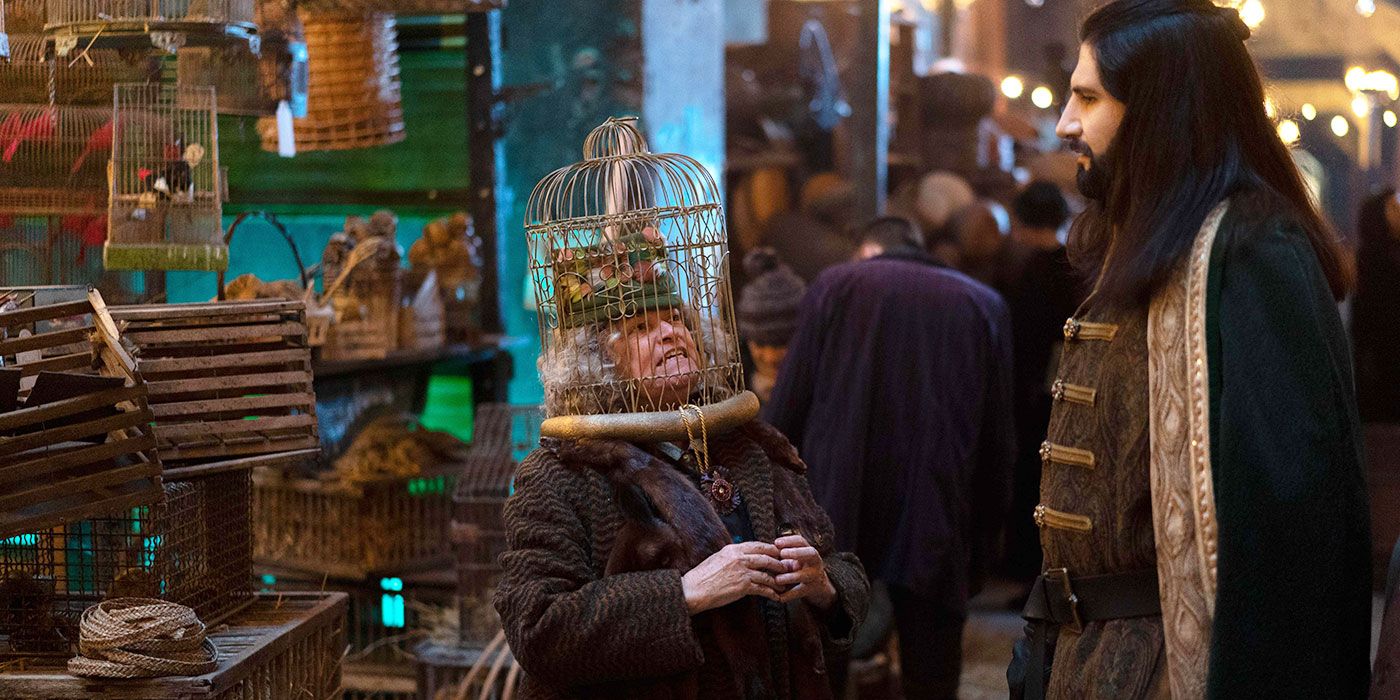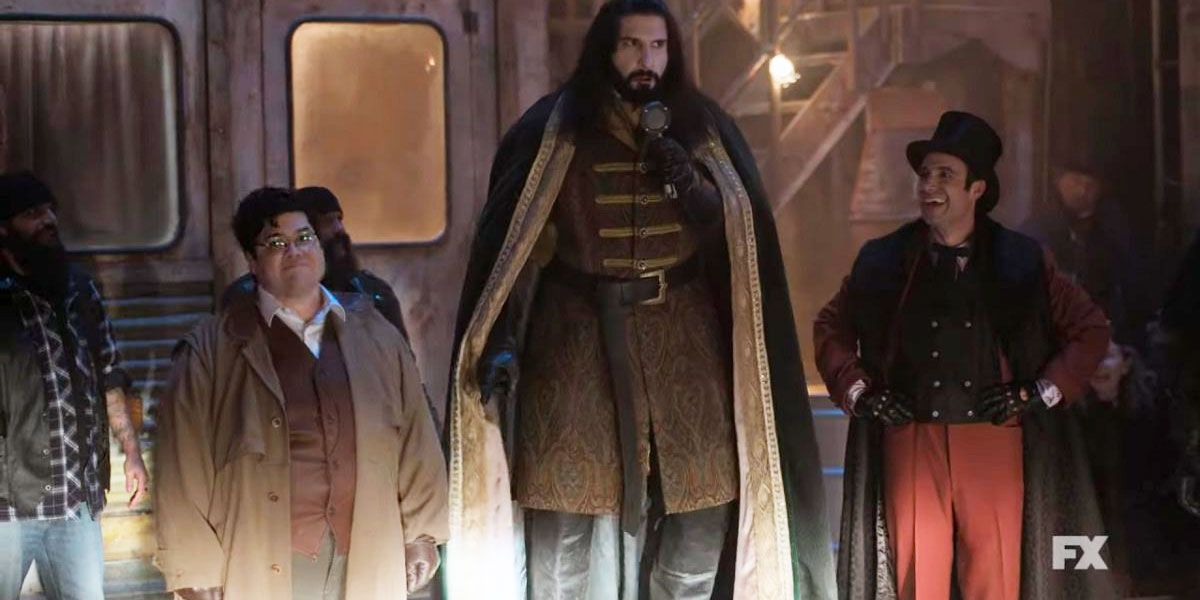Editor's note: The below article contains spoilers for Season 4 of What We Do in the Shadows.“The Night Market,” the fourth episode of FX’s What We Do in the Shadows’ fourth season, introduced all sorts of new creatures and customs to the world of the show. From meatball-making Valkyries to trash fairies to German nudists, the episode brought in several new elements of the vampires’ occult world, displaying both its wide variety and how vampires Nadja (Natasia Demetriou), Laszlo (Matt Berry), Nandor (Kayvan Novak), and Colin Robinson (Mark Proksch) fit into its spooky-silly ecosystem. It also took time to add new dimensions to the otherworldly creatures and relationships we thought we understood, from the wraiths’ capacity for collective organizing to a new and deadly use for familiars. In doing so, the episode expanded the world of the show well beyond the crumbling walls of their Staten Island mansion — and used these new creatures and customs to dig a little deeper into the characters we know and love.
Nadja’s new nightclub — aptly named Nadja’s — is a hit, but there’s one problem: the wraiths providing the labor are dissatisfied with their working conditions and are being blamed for all the odors. In an act of solidarity, they banded together into an unholy union to force Nadja to improve conditions. In response, she organizes a trip to the Night Market to procure a mystery item, leading Laszlo, the regenerated Colin Robinson child, Nandor, and Nandor’s familiar Guillermo (Harvey Guillén) into a secret and bizarre bazaar full of creatures from all walks of life (and death).
Right off the bat, we learn something new about how the world of vampires and our own interact. Throughout the series, it’s been a running joke that the veil is very thin — a simple toothpick is enough to allow Laszlo the vampire to pass convincingly as Jackie Daytona, regular human bartender. But here, all it takes is a farting busker on a subway car to separate the humans from the Night Market’s spooky clientele, revealing that there is a whole teeming underworld of supernatural creatures right under our (pinched) noses.
Once the crew arrives at the Night Market, we are introduced to a swirling menagerie of new supernatural creatures to join the ranks of the vamps, ghosts, haunted dolls, werewolves, and djinns we’ve encountered so far. Witches are real and, according to Laszlo, it’s only a matter of time before they’ll, “fight to get hold of your semen, but not in a fun way.” Little goblins, strange stinky creatures in baskets, and skeletal ghouls crowd the background. Not only do orcs exist, but apparently they look and smell enough like Guillermo that he can pass through the market nearly undetected, to his significant dismay. All the creatures, both introduced and unremarked upon, open up possibilities for this world and enliven it.
Nadja’s quest introduces us to a few distinct new types. Valkyries, described by Nadja as maidens sent by the Norse gods to Viking battlefields, are wide-eyed women with “zero banter.” Nadja doesn’t know why they sell tiny meatballs in brown sauce and strangely named, birch-colored, sleek-lined chairs, but a human passing through would recognize them from a certain big-box furniture store. But the meatballs are just as popular in the undead world as they are in ours — she trades them to the imps, who love tiny food, for a misogynist novelty t-shirt that reads, “If you can read this, the bitch fell off.” This, which seems at first to be yet another example of the central gang’s ineptitude, actually proves useful at Big Ed’s Anarchy & Apothecary, where a creature with enormous floppy ears gladly trades her vials of glowing liquid for the shirt. With this trade, we are learning not only about what new creatures are lurking in the shadows, but also that they can be just as silly, venal, and capricious as our beloved vampires.
While she’s on the quest, Laszlo has his own collection of creatures to introduce to us, and to Boy, the child version of Colin Robinson he refuses to call by that name. Through Laszlo, we learn even before we reach the market that all fairy tales have their basis in truth, whether it’s gruesome kidnappings or a shoemaker getting high on his own supply. Rumpelstiltskin? More like Rumpled-dick-skin. But once the pseudo-father-and-son duo reaches the market that's when he really expands Boy’s mind and our own ideas of this world. He shows us Pinocchio (“don’t stare, it’s a medical condition”), garden gnomes who only look like decor because they’re frozen in fear, and an emperor in new clothes — just a German nudist, the only human allowed to wander freely through the market. And fairies? They’re basically flying cockroaches who live in the trash and eat garbage, foul-mouthed in more ways than one. Lazslo shows us that if we can imagine it, the Night Market, and What We Do in the Shadows, can probably produce it. This particular supernatural world may just be limitless.
We don’t just learn about the different creatures that inhabit this world, though — we also learn about the new ways old types are put to use. Nandor and Guillermo stumble upon a Familiar Fight, which is essentially a cockfight but with familiars instead of roosters. Until now, we’ve seen familiars as servants, left in dingy back rooms to wait for their masters. In the Night Market, we see that they can also be sources of entertainment and pride for their masters, rewarded with Kibbles and Bits and certain death. “Remember to take your familiars’ corpses with you when you leave!” the smarmy vampire emcee mentions, shortly after removing one familiar’s head to a chorus of cheers. Even before Nandor and Guillermo’s climactic fight, this set piece expands how we think about familiars in this world — and how we view the evolving dynamic between Nandor and Guillermo.
This episode and its namesake outing likewise give us new insight into the wraiths, who until now were faceless, nameless, voiceless servants to the Guide (Kristen Schaal). We learn they have the ability to organize, that they can communicate by impeccable penmanship, that their favorite pastime is haunting those who wronged them, and, most crucially for Nadja, that they are in constant pain. We also learn that “solidarity forever” has its limit for the wraiths. When, in exchange for their compliance, their leader Xerxes accepts Nadja’s offer of Waterlily of the Nile — the narcotic that eases their constant pain, which was Nadja’s errand at the market — they simply devour him and restart negotiations. Solidarity only sometimes. The reinvention of the wraiths is a reminder that the world of this show is nimble and flexible, and that nothing is necessarily the way it appears.
But “The Night Market” doesn’t just show us all these varied new creatures and customs for fun — this vastly expanded world also expands the internal landscapes of the vampires themselves, giving us new insight on Nadja as a boss, Laszlo as a dad, and Guillermo and Nandor as an uneasy team.
When the topic of the wraiths labor movement is first broached, Nadja’s response is in line with how she ran the Vampiric Council in the third season: “This I know how to handle — kill them all!” But she doesn’t. Instead, we see her take patient steps to enact a plan to bring her employees in line, and then immediately cave when she knows she’s been beaten by underestimating the wraiths. Despite herself, she has grown as a leader and a boss. Laszlo doesn’t introduce us and Boy to all the new creatures for his own amusement; he does it in a bid to help his son (though he’d never admit to that title) see the truth of the world. And Nandor and Guillermo’s fight shows us how unusual this vampire-familiar relationship is in this particular world — not only does Nandor not want to offer his “closest companion for 13 years” up to be gleefully murdered, as the other vampires would, but he goes so far as to concoct a plan to save him. Their fight does get a little too real, but it ends in teamwork, with Nandor muttering, “You okay?” to a fake-dead Guillermo. By expanding the variety of ways the vampire-familiar relationship is enacted in this world, we can also see more clearly what makes this evolving relationship special within it.
“It gets very heavy from here,” Laszlo warns young Colin Robinson after the opening two lines of his bedtime story, In Cold Blood by Truman Capote. Throughout the episode, he’s endeavored to show the young boy the truth of the world, to disabuse him of the notions he’s absorbed from fairy tales. In “The Night Market,” we learn that the truth of the world of What We Do in the Shadows is far more varied and extensive than we may have thought, full of just about every creature that goes bump in the night (or, in the Valkyries' case, in the kitchen). By introducing so many new types of ghoul and goblin, and by reinventing what we thought we knew about the things we’d already met, the show expands its own landscape, situating our gang in a much more vast environment than their Staten Island block permitted us to see. Like the Night Market’s infinite alleys, the possibilities are endless.



